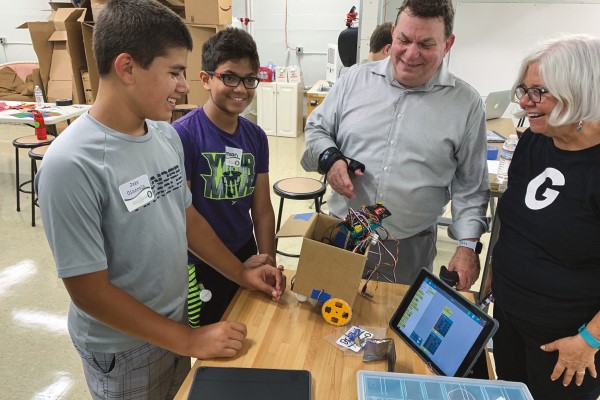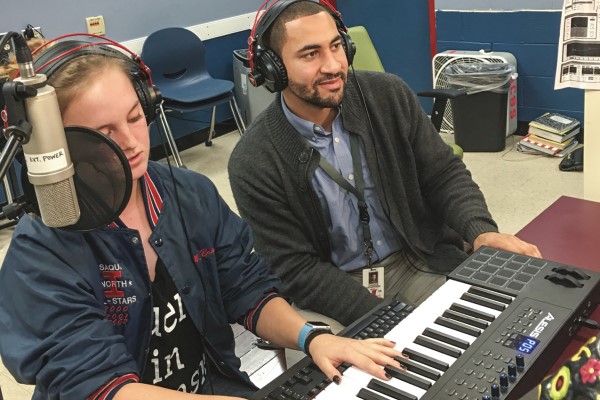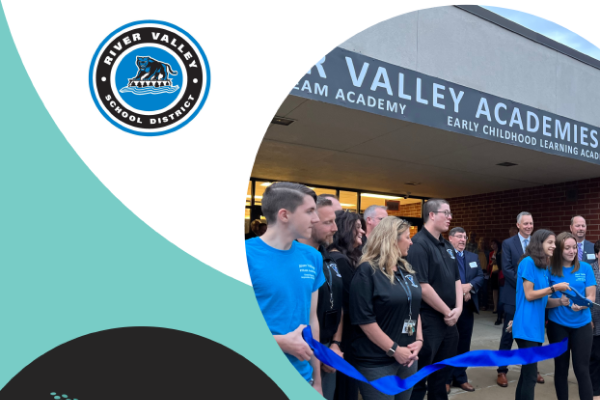Radical Change Through the Practice of 'Making'
October 01, 2019
Developing lifelong competencies while engaging learners in their passions

When learners make, the entire concept of school changes. Instead of being bored to tears, as too many secondary students across America describe themselves, maker learning captivates students. “It was 5:15 p.m. on the Friday before spring break,” the head teacher at Center I shared, “and I was trying to kick kids out.”
Integrating learning experiences that support students as makers represents one radical innovation that allows students to demonstrate deeper learning even as they together synthesize collective knowledge and skills. When students make — whether writing and performing a play, building a guitar or a robot soccer player, recreating an 1837 original telegraph or constructing a tiny house — they share learning not as a meaningless collection of trivia, but through their capacity to understand their world and influence it.
In today’s Smart Machine Age, rapidly changing landscapes demand learners who will form a society of creative, adaptive, collaborative problem solvers. This presses educators toward radical change in learning experiences so that Generation Z (and those generations that follow) will not find formal education irrelevant and decide to abandon it, according to Sieva Kozinsky, in “How Generation Z Is Shaping the Change In Education” in Forbes.
Radical innovation is necessary to move from circa 1920 to contemporary, student-centered learning. Large-group, single-age, single-subject instruction was not chosen in the early 1900s as a path to inclusion, access and equity.
Imagine what communities would create if we designed schools from scratch beginning with deep change in how school community members ascertain what learners’ user experiences must become. Changing the experiences of contemporary learners requires radical innovation of the user interface. It demands rethinking the whole process of what learning could be. It demands that educators spend time with young people to hear their voices, observe what creates learning agency within them, and find out how they would like to influence the world in which they live.
Change must be sufficiently transformative for today’s learners, altering the unquestioned DNA of American schools, changing the user interface of culture, structures and curriculum that were created for a different time and place in America’s educational history. Sufficient transformation does not happen by chance. It occurs through zero-based thinking, leaving “yes but ...” responses on the cutting floor and supplanting them with “what if” questions that push possibilities we might otherwise not pursue.
Radical Innovation
While this space was developed as a unique test bed for change, the district has had a commitment for more than a decade to transforming school environments, culture, technology uses and instructional design to expand the bandwidth of opportunities for all students. Integrating both “make to learn” and “learn to make” approaches has afforded students of all ages opportunities to explore design, invention and entrepreneurship in their work.
This past year, they were willing to take a chance on something completely new: a school located in a 42,000-square foot, one-time telephone factory, built for less than a million dollars in a former storage loft located above a custom digital design company and a plumbing supply business.
Center I is neither a collection of star students nor a gathering place for traditional school “failures.” Rather, the first cohort of students at Center I came from some of America’s most creative public schools — places with embedded maker opportunities — but these kids knew they needed more.
Aspiring for More
These high schoolers are learning to manage their own time, to fit the dictates of the state curriculum into their passions, to set their own expectations and to prove they are ready for adulthood. Making helps define their learning.
In the school’s short existence, students at the center have constructed musical instruments, produced videos, built arts portfolios, developed virtual reality journeys and told stories through podcasts. They research, communicate, collaborate and produce a culture of accomplishment. They have mentored younger children, including those we label “at risk,” through make-to-learn experiences.
Promoted as a school that maximizes flexible scheduling and a personal approach to learning, Center I emerged from a long-term strategic campaign to describe a “high school of the future.” This focus, in part, led to a capital study in 2017 that set the stage to create community-based learning centers in lieu of building another comprehensive high school.
This student’s joyous reaction came in June, which marked the end of year one of Albemarle Tech, or Center I as it’s now called, a one-of-a-kind high school in Charlottesville, Va. The leaders of Albemarle County Public Schools, including us, strategically planned a radically different public high school where a “maker” philosophy, technology and real-word internships created a student-centered culture.
“A-Tech is much more than a center for learning. It also is a center for helping students like me hold on to their dreams and help them work towards them. I truly believe this is the future of learning.”

Four Transformations
The art of radical innovation ultimately lies, we believe, in returning humanity to our schools after a generation spent worrying about numbers, averages, means and treating students as products to be analyzed and categorized. Maker education does this. In fully embracing human-centered learning and engagement, basic tenets of the maker culture, educators facilitate students to find their future, bringing forward their passions within an inclusive community.
We see four transformations emerging from radical innovation of experiences afforded to young people when educators have embraced human-centered learning with maker education at its core.
Shifting power from teachers to learners.
The difference between “project-based learning” and “making” is this: Project-based learning allows the teacher to bring context to content, adding the “why”
that hopefully engages kids. Making brings content to context, using student interests, questions and passions as the foundation to add in curriculum and competencies. Making begins with the student. When a teacher encourages and supports making as
a learning path, the learning power shifts from the teacher to the student.
As one center student built musical instruments, it was easy to integrate math, physics, history and literature into that work. He co-developed with his teacher how to assess his progress and accomplishments. His ownership of learning through making represents learner empowerment as a value proposition.
Empowered learners are ready for life. They learn to manage time. They know how to use spaces well and how to communicate their questions, failures and successes. They know how to collaborate, locally and globally, and they understand humanity. Students cannot learn to work this way if we continuously tell them what, where, how and when to learn — and those who cannot adapt to a changing landscape will likely fail in this century.
Actively pursuing learning through curiosity, questions and personal interests.
Leveraging the curiosity and questions of learners produces a context for exploration, research, design, engineering, creation and students’ agency.
One teenager in a district high school, stunned by the death of her school bus driver because of diabetic neuropathy, spent two years developing shoe orthotics that would provide foot pressure feedback to a patient. Her work began with a question of why he died and led to a project that integrated all the advanced STEM skills anyone could hope for but also the human skills of empathy and compassion.
Paving
multiple pathways to learning.
Universal Design for Learning as a pathway to equity for all learners represents more than multiple means of representation, expression, and engagement in learning typically reserved as special accommodations
for children with disabilities. Everything we do — spaces, schedules, classroom management, technologies, assessments and schools organized by grade levels and learner age — must change to expand the bandwidth of success that can occur
when UDL is built into the system so that learning accessibility and equity is extended to and benefits all learners.
When a rising 7th grader arrived at a maker camp (a replacement for traditional summer school) having failed most classes, he found the opportunity to be challenged by his own question: “I’m a [baseball] catcher,” he shared. “Pitchers think they’re throwing strikes when they’re not. How can I fix that?”
Beginning there, he designed, engineered, constructed and even pitched — to venture capitalists — an Arduino-controlled, laser grid system that determined balls and strikes. He couldn’t pass 6th-grade math or sit still in a classroom, but he could learn anything, communicate effectively, and teach others when learning opportunities were adapted to his interests and needs. When he, and not decontextualized instruction, became the focus, his learning became personal, real and a reflection of authentic Universal Design for Learning.
Learning for a humane life.
When we arbitrarily control children’s decision making, whether through rules governing when kids eat and drink, whether they can use the bathroom, what they learn, or even by removing informal play
time from schedules, we prevent children from developing executive functioning, blocking their capability to learn social-emotional competencies needed in life.
School can be different. When a few teens noticed a peer with multiple disabilities unable to feed herself in their school cafeteria, they identified a need and an opportunity. In their high school’s library “genius bar,” they determined what their fellow student needed. Then they designed and constructed a new user interface for her using computer-aided design and 3-D fabrication. The result: a spoonlike device she used to eat on her own for the first time.
This wasn’t accomplished through adult-owned curriculum. No state test could assess their work. Their learning began with empathy and ran through the tools of their lifetime. It emerged from their own agency as learners in a school where educators believed in and nurtured students’ capability to make a difference.
Human-Centered
Humans are makers by nature. Humans are social. Humans care about others. Human-centered learning answers the needs of today’s children and this century.
In the end, nothing is more critical to developing the humane competencies of life than engaged learners, and what engages humans is making that is based in curiosity and passion — the art of creating with and for others. Taking education back through
making is radical indeed, a radical return to humanity.
About the Authors
Pam Moran is executive director of the Virginia School Consortium for Learning in Charlottesville, Va.
Ira Socol is senior provocateur and learning environment specialist at Socol Moran Partners in Charlottesville, Va.
They are co-authors of Timeless Learning: How Imagination, Observation and Zero-Based Thinking Change Schools.
A User Interface That Better Connects With Students
In Timeless Learning: How Imagination, Observation and Zero-Based Thinking Change Schools, we share a narrative of educators who’ve radically changed the user interface of school to support the user experience that learners need and desire. These are educators who defy the metaphor of interaction with the poorly constructed interface of a customer call center that results in spending precious time on hold, seeking to speak with a human who cares about our problem — only to find ourselves disconnected when we get a human voice on the line. That’s not the user experience we want for our learners.
In school, educators control the user interface of learning through design — use of time, schedules, services, technologies, space and rules governing culture. The interactions of learners with the interface of school lead to more or less desirable and necessary user experiences.
Students’ levels of engagement, love of learning, social-emotional
competency, personal satisfaction, and sense of belonging and
accomplishment are shaped by our intentional design of school. If we
want students to assess their user experience as positive, valuable and
useful to them, we have to design for space, culture, technologies and
pedagogies that lead to that result. We have to align philosophy,
policy, professionalism and practice with learners’ experiences in mind.
Otherwise, the user experience that our learners report is their
version of the schools of the past.
— PAM MORAN AND IRA SOCOL
Advertisement
Advertisement
Advertisement
Advertisement



.png?sfvrsn=3d584f2d_3)